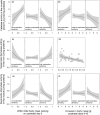Early life parameters and personality affect oxidative status during adulthood in an altricial rodent
- PMID: 36200138
- PMCID: PMC9535260
- DOI: 10.14814/phy2.15427
Early life parameters and personality affect oxidative status during adulthood in an altricial rodent
Abstract
It is increasingly recognized that alterations of the cellular oxidative status might be an important cost underlying challenging early life conditions. For example, an increased litter size can impose challenges as the offspring will face increased competition for maternal resources. Within a litter, individuals with relatively higher starting mass typically show higher growth rates, which can lead to increased oxidative damage. We investigated the long-term consequences of these early life parameters on the oxidative status in mature mound-building mice (Mus spicilegus). Individual differences in the animals' exploration tendency were assessed by repeated open field and novel object tests. We predicted less exploratory phenotypes, which typically show a higher stress responsiveness, to be particularly susceptible to possible effects of these early life parameters on oxidative status. We quantified oxidative damage of DNA (8-hydroxy-2'-deoxyguanosine levels, 8-OHdG) and proteins (protein carbonyl content, PCC), and activities of the antioxidants catalase (CAT), glutathione peroxidase (GPx), and superoxide dismutase (SOD) in liver and skeletal muscle tissue. 8-OHdG levels were positively associated with CAT and SOD in both tissues, indicating that increased oxidative DNA damage was associated with an upregulation of antioxidant production. Hepatic DNA damage after maturity was increased in animals from larger litters. In less exploratory animals, DNA damage and the activity of CAT and SOD in the muscle were increased, but only in individuals with higher relative starting mass (measured on postnatal day 9). This interaction may be explained by the typically higher adrenocortical activity in less exploratory phenotypes and by the higher growth in relatively heavier pups, two factors known to increase oxidative stress. These findings contribute to enlightening the complex interplay between early life conditions, personality, and oxidative status.
Keywords: Mus spicilegus; DNA damage; exploration tendency; litter size; mound-building mouse; oxidative stress.
© 2022 The Authors. Physiological Reports published by Wiley Periodicals LLC on behalf of The Physiological Society and the American Physiological Society.
Conflict of interest statement
The authors declare that there are no conflicts of interest.
Figures


References
-
- Alonso‐Alvarez, C. , Bertrand, S. , Faivre, B. , & Sorci, G. (2007). Increased susceptibility to oxidative damage as a cost of accelerated somatic growth in zebra finches. Functional Ecology, 21, 873–879. 10.1111/j.1365-2435.2007.01300 - DOI
-
- Bates, D. , Maechler, M. , Bolker, B. , & Walker, S. (2015). Fitting linear mixed‐effects models using lme4 . Journal of Statistical Software, 67, 1–48. 10.18637/jss.v067.i01 - DOI
-
- Bautista, A. , Zepeda, J. A. , Reyes‐Meza, V. , Martínez‐Gómez, M. , Rödel, H. G. , & Hudson, R. (2015). Contribution of within‐litter interactions to individual differences in early postnatal growth in the domestic rabbit. Animal Behaviour, 108, 145–153. 10.1016/j.anbehav.2015.07.028 - DOI
Publication types
MeSH terms
Substances
LinkOut - more resources
Full Text Sources
Medical
Miscellaneous

